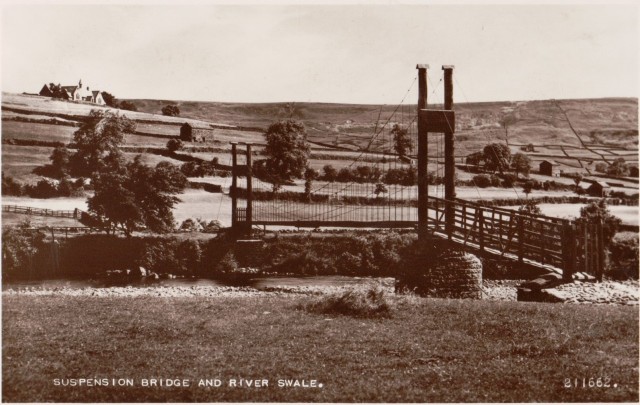Almost everyone who enjoys walking around the Reeth area in Swaledale will know of the footbridge over the River Swale, known locally as Reeth Swing Bridge or sometimes as Harkerside Swing Bridge since it links these two communities. Two stories of interest relate to this structure.
The first unravels a puzzle – why it’s called the swing bridge, when it’s a fixed-span suspension bridge? To learn why, read here: Doesn’t swing? Oh yes it does!
The second story searches behind a phrase on the information board next to the bridge, which explains that the predecessor of the current structure was built in 1920 ‘after the community helped raise the money to connect the parishes of Grinton and Reeth’. In fact, nearly 100 years ago the community did a lot more than help fund the bridge, and a mix-up over a deal with the council left a handful of Harkerside farmers having to pay a lot more than they had originally offered. For this story, read on below.
How the original Reeth Swing Bridge left farmers paying more than planned
The original idea was for a bridge in a different place. In April 1914, Mr E Alderson formally requested Reeth Parish Council to build a bridge over the River Swale at Healaugh. No reason for it was recorded, and at this distance in time it’s difficult to imagine what the reason might have been. The council decided that a more useful site would be farther downstream, opposite the Friends School at Reeth, with the implicit benefit of making it easier, quicker and safer for the children of Harkerside farmers to get to school.
The river had long-since been crossed at this point by stepping stones, which were dangerous at the best of times and impassable when the river was in flood. So a letter was sent from Reeth Parish Council to the Grinton Parish Meeting to ask if they would share in the cost of a bridge. A special meeting of Grinton Parish was called to consider the request, and surprisingly resolved unanimously that the matter should be ‘left over for future consideration’.
Clearly frustrated, Reeth parish councillors decided at their next meeting to ask the next tier up in the local government structure, Reeth Rural District Council, to build the bridge, provided the Harkerside landowners would pay half the cost. All the Harkerside farms were tenanted, and the freeholds at this time were split between just two members of the landed gentry, who lived elsewhere, and who might perhaps have taken some persuasion to cough-up for a bridge.
The Great War intervened. Landowners suffered huge depreciation of land values and by the end of the war many were selling up and accepting poor prices. By contrast, most working farmers, even the small hill farmers of Harkerside, had enjoyed significant financial benefits during and immediately after the war because food shortages had led to continuous rapidly rising prices. A crash was looming in 1921, but when in December 1919 the issue of the bridge was raised again at a meeting of Reeth Rural District Council, the local economy was buoyant. So the council surveyor was instructed to do a feasibility study and costing, which came in at just over £100.
An important factor at this time was that the idea now had an influential backer among the Harkerside residents. This was Tom Brown, a farmer and cattle dealer of Scarr House, who had been a clear beneficiary of the recent boom in agriculture, and who in May 1919 had been elected the member for Grinton on Reeth Rural District Council. Apparently after some canvassing among his fellow residents, he told the council in February 1920 that six of the nine Harkerside householders had pledged to pay a total of £65 towards the cost of the bridge, provided the rural district council would pay the rest.
Clearly the idea of tapping the landowners for a contribution had been abandoned as a lost cause. Reeth Rural District Council proposed a counter offer. Provided the Harkerside inhabitants pay two-thirds of the cost of the bridge, whatever it turned out to be, the council would pay the remaining one third and take over future responsibility for the bridge. It seems that everyone forgot that this proposal actually needed to be agreed.
J Hird of Marrick was hired to build the bridge, and it was completed in December 1920 at a cost of £161 6s 10d. One of the landowners, the Winn brothers of Wensleydale, unexpectedly contributed two trees for the woodwork.
When the bill was in, Matt Calvert, one of the leading Harkerside farmers, wrote to the council pointing out that he and his neighbours had now contributed £85 towards the total, more than they had offered, and since the council had paid only one third, there remained a shortfall of £22 11s 2d. He proposed that the Harkerside residents and the council split the outstanding balance equally. The council responded that it had paid its promised share and would not pay any more.
So the Harkerside residents, whether they thought they had agreed it or not, ended up paying the two-thirds share of £107 11s 2d. It isn’t known whether the burden fell entirely on the original six, or whether in the end more, or all, of the Harkerside householders contributed something; or even whether the landowners chipped-in some cash at the eleventh hour. But it’s clear that at least some of the Harkerside farmers were not happy with the outcome.
After the bridge’s destruction in a flood in 2000, its replacement, said to be an almost identical copy of the original, was funded by multiple agencies led by the Yorkshire Dales National Park Authority. This seems to have been an altogether fairer system of funding, especially as today there are no pupils of Reeth School living in Harkerside, and the bridge is probably used more often by visitors than by locals.
See also: Doesn’t swing? Oh yes it does!

